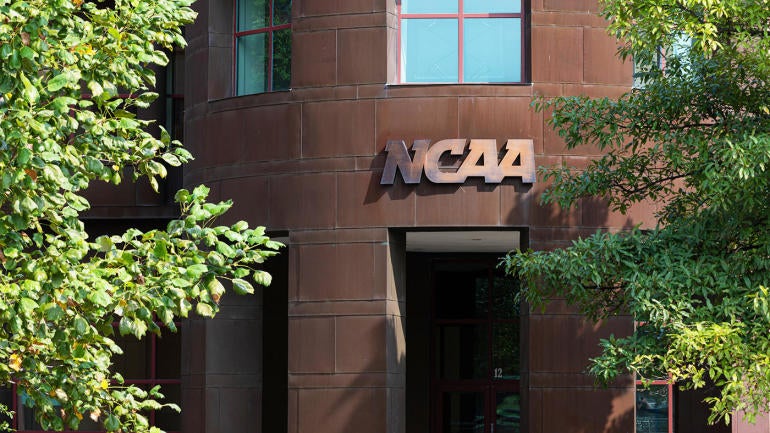
LAS VEGAS -- If there is a college athletics revolution in the near future, the NCAA is now admitting it wants to be part of it.
In a letter sent to membership Tuesday, NCAA president Charlie Baker proposed sweeping changes to his association's amateurism model that would essentially create pay for play between schools and athletes.
Baker proposed a new subdivision consisting of schools "with the highest resources" that would likely separate itself from the rest of the Football Bowl Subdivision (FBS) -- as well as the rest of Division I -- with its own rules and regulations. The remaining schools in FBS would still have access to the College Football Playoff.
The new subdivision would give schools the ability to arrange NIL deals for athletes with no cap on compensation. That signals an unrestricted, direct pay for play model that is a nod toward current lawsuits that seek to remove regulations around compensation.
Schools would be required to invest at least $30,000 per athlete annually in an "enhanced educational trust fund" for "at least half" of its athletes.
The "highest resources" reference had stakeholders buzzing Tuesday morning as folks wondered whether such language could trigger another round of realignment.
While the Power Five conferences will go forward as the Power Four amid the collapse of the Pac-12, there is a general feeling that the Big Ten and SEC have, at least in theory, separated themselves from everyone else by virtue of their new media rights deals.
Baker's proposal would formalize a new major-college subdivision for the first time since 1978.
"This is the true break [from the rest of the FBS]," one athletic director said Tuesday.
Prior to Tuesday, the association had mostly been reactive to big-ticket issues it has faced. Now, it wants to at least control the narrative regarding player compensation and make a major admission: It can't cap compensation.
"I think, ultimately, if implemented, it is likely an interim stop [before] full employment," said David Ridpath, an official with Drake Group, a reform-minded higher education watchdog. "But it is a radical proposal, and I credit Baker for recognizing that change has to happen and the same old, tired amateurism and education sound bites don't work anymore -- if they ever did."
Baker will address the proposal Wednesday in Las Vegas during the Sports Business Journal Intercollegiate Athletic Forum. NCAA stakeholders (ADs and commissioners) were not provided with the details of the proposal until the letter was released.
"We are all trying to process this right now and what it means," one Power Five AD said.
All of it signals a revolution, an admission that the collegiate model the NCAA so doggedly endorsed is dead -- for the first time at the suggestion of the NCAA. This sort of revolution is basically why Baker was hired in the first place.
It's a rarity that the NCAA is proactive on substantive issues of this measure. Baker, the former Massachusetts governor, was able to work quickly. He got this issue on the table nine months after taking office. It eventually means little if the membership doesn't jump on board beginning at next month's NCAA Convention.
There are still major lawsuits making their way through the system that may render any change moot. However, Baker's timing Tuesday was such that the NCAA could implement change before those lawsuits go to trial in 2025.
"Paying the players is a step in the right direction," said former USC star Reggie Bush. "Now, we've got to figure out a way to take care of these guys [medically] after their sacrifice."
There is already legislation in place for enhanced medical benefits. The NCAA is set to provide a health insurance plan that would provide coverage if athletes are injured. It would provide coverage for a period after their eligibility expired.
This is at least the NCAA admitting that a pay for play model is coming; whether it gets to oversee it is another question. The association wants to be on the record as in favor of such change. The proposal seems to indicate that those schools with the "highest resources" could adopt their own rules regarding transfers, scholarship limitations and recruiting.
If the new subdivision wants to offer, say, 150 scholarships instead of the current 85, that would be allowed. What will happen to the rest of the FBS is not clear.
"Whether that's the answer, I'm not sure," said Roy Kramer, the 94-year-old former SEC commissioner, of the proposal. "Some [part] of that is there because it's already built into the culture we have now. We've got to have a way to manage it. We've got to have some kind of national standard."
The proposal is so revolutionary because what previously would have gotten schools the death penalty would now be the way of doing everyday business. NIL benefits have been allowed by the NCAA since July 2021, but they cannot come directly from schools. With this proposal, schools would essentially become business partners with their athletes.
NIL was only implemented after the NCAA was admonished by the Supreme Court in June 2021 over fighting against a limited set of education-based benefits. Since then, NCAA has been on the defensive adopting a narrow set of NIL rules. It has been approaching Congress almost since that day requesting a federal law regulating NIL.
"I don't know if the proposal is much different from what we have now," said former Florida quarterback Tim Tebow, who entered the College Football of Fame on Tuesday. "I need to think through it with all the nuances. … Right now, it's NIL through the collectives to the players. … It's interesting."
The next issue -- actually the issue -- becomes determining who can afford it. The FBS currently consists of 133 schools that have athletic budgets ranging from $19 million to $250 million. Beginning next season, there will 68 schools among the ACC, Big Ten, Big 12, SEC and Notre Dame.
A new subdivision could conceivably include those schools. However, it could put budgetary strain on some of the lower-tier programs (financially), and other programs outside those 68 might be tempted to increase their budgets to join the new subdivision.
Cincinnati ($83 million) and Houston ($78 million) have the two smallest athletic budgets among current public Power Five schools, according to the USA Today database.
Wake Forest and Boston College, small private institutions, don't have to publicly disclose their budgets. However, both are estimated to have budgets right around those two Big 12 schools.
The last time Division I subdivided 46 years ago, it was over frustration that smaller schools could block NCAA legislation needed by larger schools. That's when Division I-A (now FBS) and Division I-AA (FCS) were formed. There are currently 362 Division I schools.
The same frustrations apply today. SEC commissioner Greg Sankey this year voiced his annoyance at the lack of engagement by the NCAA Council and the composition of top NCAA governing bodies.
Outgoing ADs at both Notre Dame (Jack Swarbrick) and Ohio State (Gene Smith) both said this year they favored a model that would more liberally compensate athletics.
Greg Sankey just reiterated his frustration with NO ONE on the NCAA Council speaking up on issues at a recent meeting he attended. Unstated but assumed in that frustration, only 7 of the Council's 39 members are from P5 schools.
— Dennis Dodd (@dennisdoddcbs) August 8, 2023
















